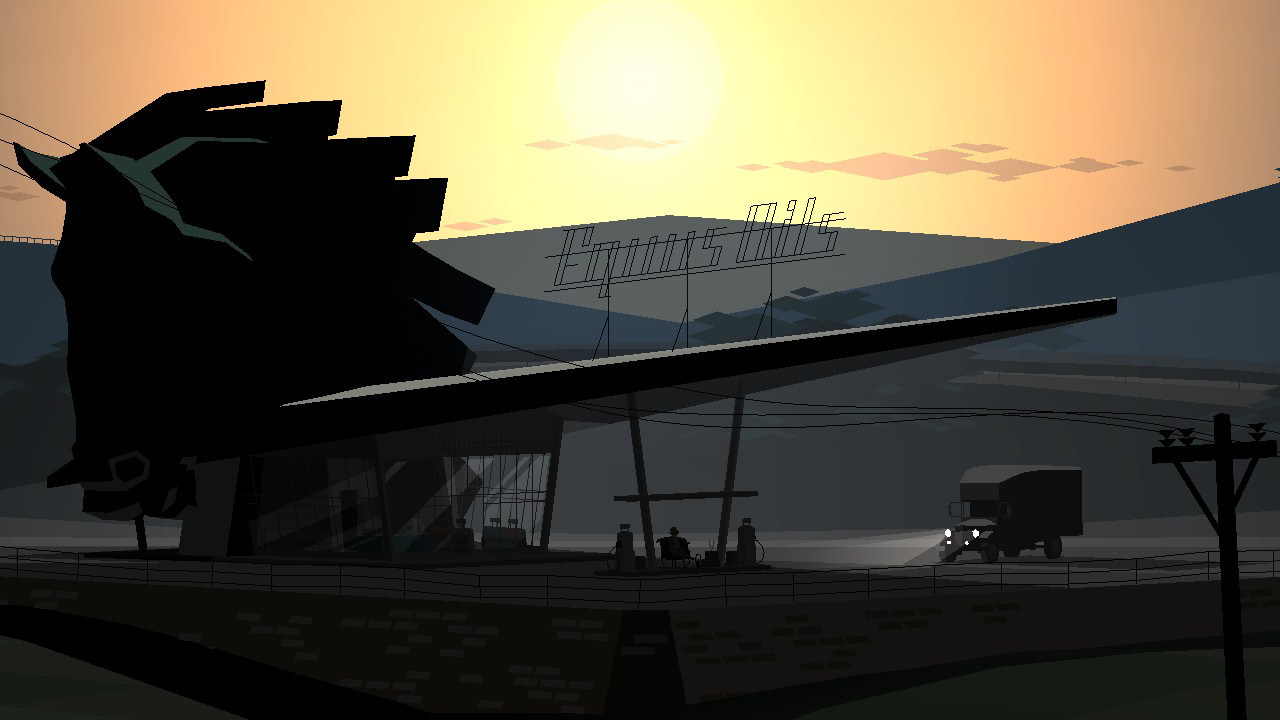Kentucky Route Zero is probably the most intellectual game I have ever played. It’s a five-episode title that made me feel dumber and dumber the more I played through it. It doesn’t do it on purpose (I think), but it made me realize that I should try and better myself when it comes to my vocabulary and reading comprehension skills. I worried that I might be the only one being obtuse about the dialogue and narrative but felt too afraid to ask others that I knew who were also playing Kentucky Route Zero if they were feeling the same way.
By the time I finished the second episode, I truly had no idea what was going on outside of the main quest to find route zero so that a man named Conway could make his final delivery for an antique shop. But even with all the confusion and ignorance that I had experienced, I was compelled to learn more. Compelled to find out the reality of what was really going on in this weird, oblique journey. Starting as just a pit stop to look for directions at a gas station, Kentucky Route Zero took me on an uphill road that continued to get weirder and weirder and I went with it for no reason more than the sake of curiosity.
As a narrative-driven title, Kentucky Route Zero has some of the most humanistic characters I have experienced in gaming. It is a bit unorthodox with there really being no main protagonist, but instead a group that grows larger as the game progresses. You control all these characters at a point and the dialogue option you pick during a conversation determines who is going to reply. Each member of the group is unique and likable for all their own reasons, but how much you learn about their backgrounds is based on how much you decide to invest in them. This is both a positive and a negative. At a certain point, you have to choose which characters you want to interact with as the player, but you will lose out on those you did not pick requiring you to go through the game twice to get all of the exposition.
The different ways that developer Cardboard Computer integrates the storytelling into the characters can be relatively hit and miss, but when it does shine it does so brightly. At times, characters that aren’t even shown on the screen at any given point tell their stories in a way that makes sense and pushes the narrative forward in surprising ways. Conversely, there are moments that hurt it as well.
In case you didn’t already know, Kentucky Route Zero makes you read a lot. There were a fair amount of times where giant paragraphs would come up that felt like they had little no importance in the story which made me want to graze over them. That being said, this is not a game that you will be able to play one time and understand all of the complexities of its story. For those that Kentucky Route Zero speaks to, they may love to go back and dissect its story more, but for most, I don’t think that’ll be the case. As a fan of narrative-heavy titles similar to this, I do not want to have to play through a slow-paced dialogue-heavy game to get the complete picture. Still, there are specific setpieces in Kentucky Route Zero that may make me want to return in the future.

I guess my main criticism for Kentucky Route Zero is that I don’t feel any sense of purpose in the story being told. It feels disjointed, random at times, and asks you to go along with it even though there isn’t much closure by the time it’s finished. Certain character plots end abruptly (including the game itself) that you have to accept and move on, but with no payoff or sense of fulfillment. Between acts, there are mini-acts that you could consider as a type of intermission meant to set up plot points for the upcoming episode. Similar to the overarching game, they are pretty inconsistent. These segments are straightforward, but whether they end up being necessary or not is a different discussion. While the majority of them added a little bit more exposition for the game, some of them felt near pointless.
I understand that the main quality that should be appreciated in Kentucky Route Zero is the different ways in which Cardboard Computer makes the player interact with people and objects to tell its story. But when the narrative is a roller coaster of major highs and lows at points, I was hoping for a big revelation to come about. In the end, Kentucky Route Zero is a unique game that will only speak to a small sum. I see and appreciate the great things that it does for narrative games, but when the story itself isn’t all that interesting, it just seems to be weird just for the sake of it.
Even with its faults, Kentucky Route Zero is well-written and contains wonderful art and sound design. I heard great things about Kentucky Route Zero before the release of its final act and I do see a special game inside, but there are too many noticeable issues for me to praise it on the same epitaph that others do. I hope that someday I might give it another shot and it will finally click.
The post Kentucky Route Zero: TV Edition Review — Keep The Truck Runnin’ by Cameron Hawkins appeared first on DualShockers.
